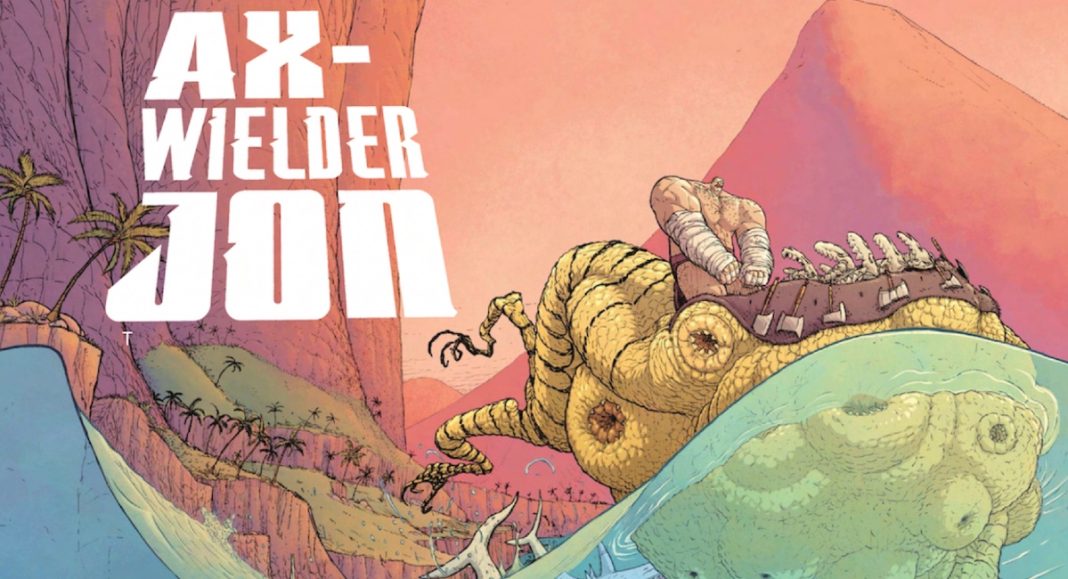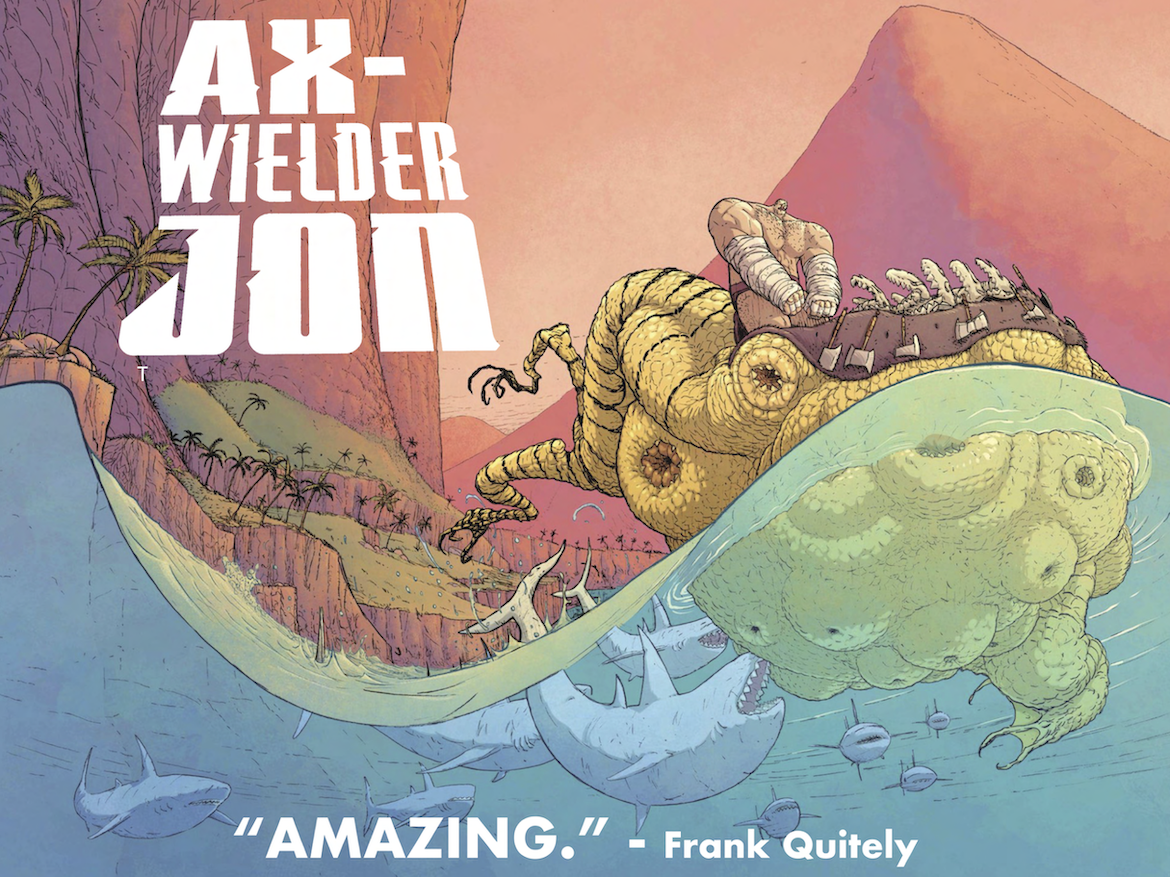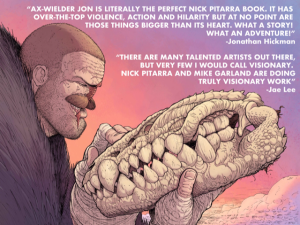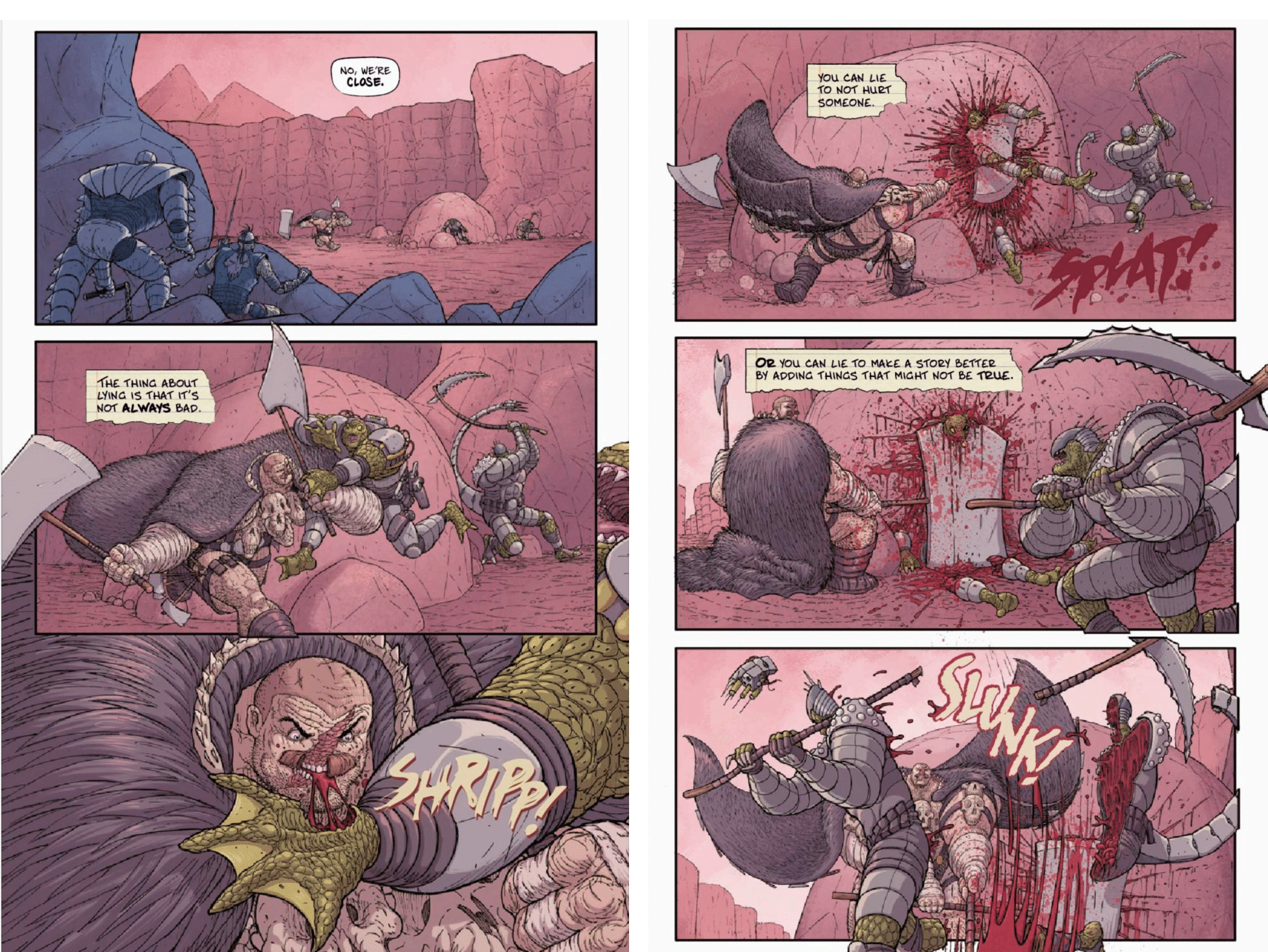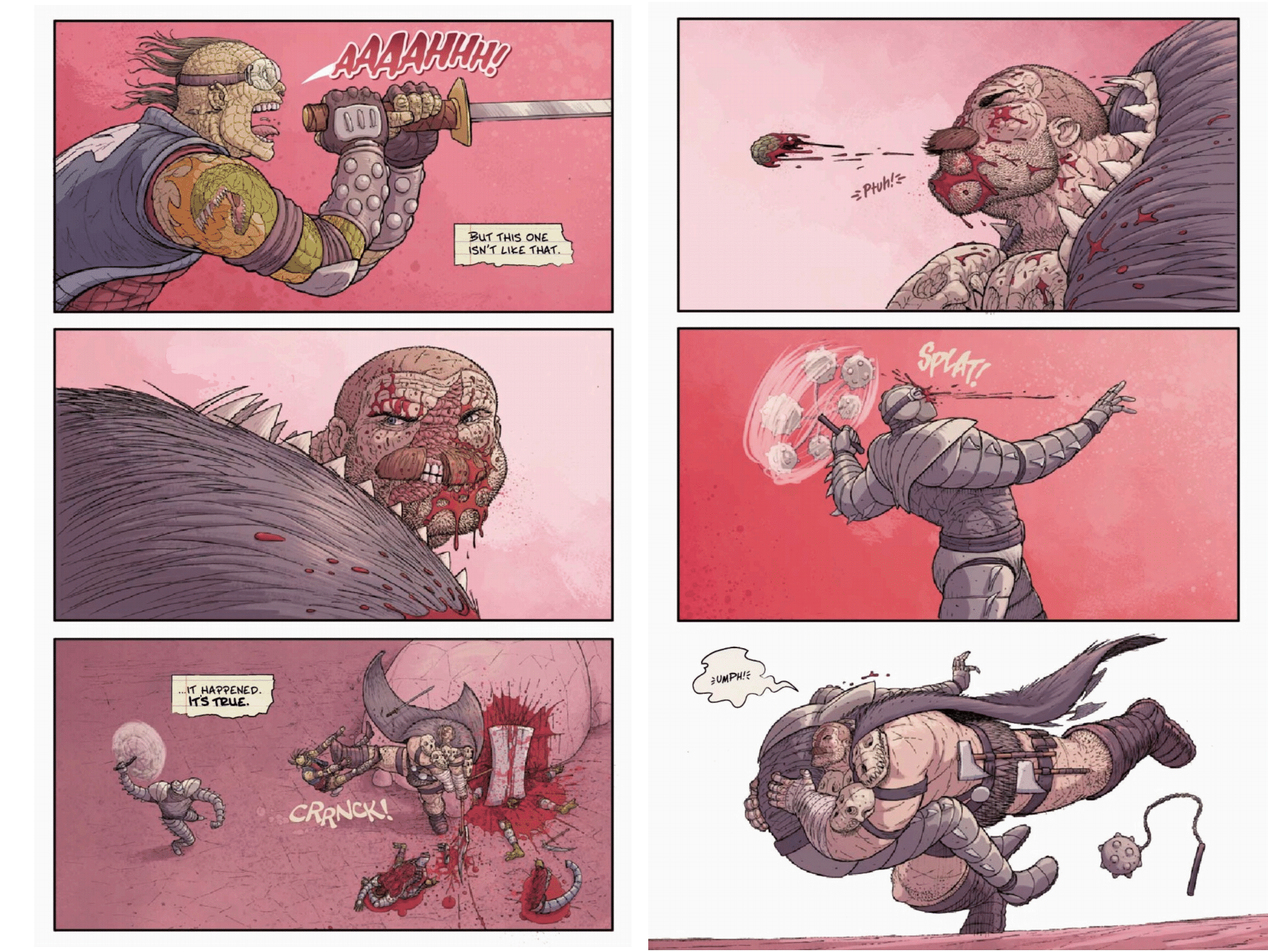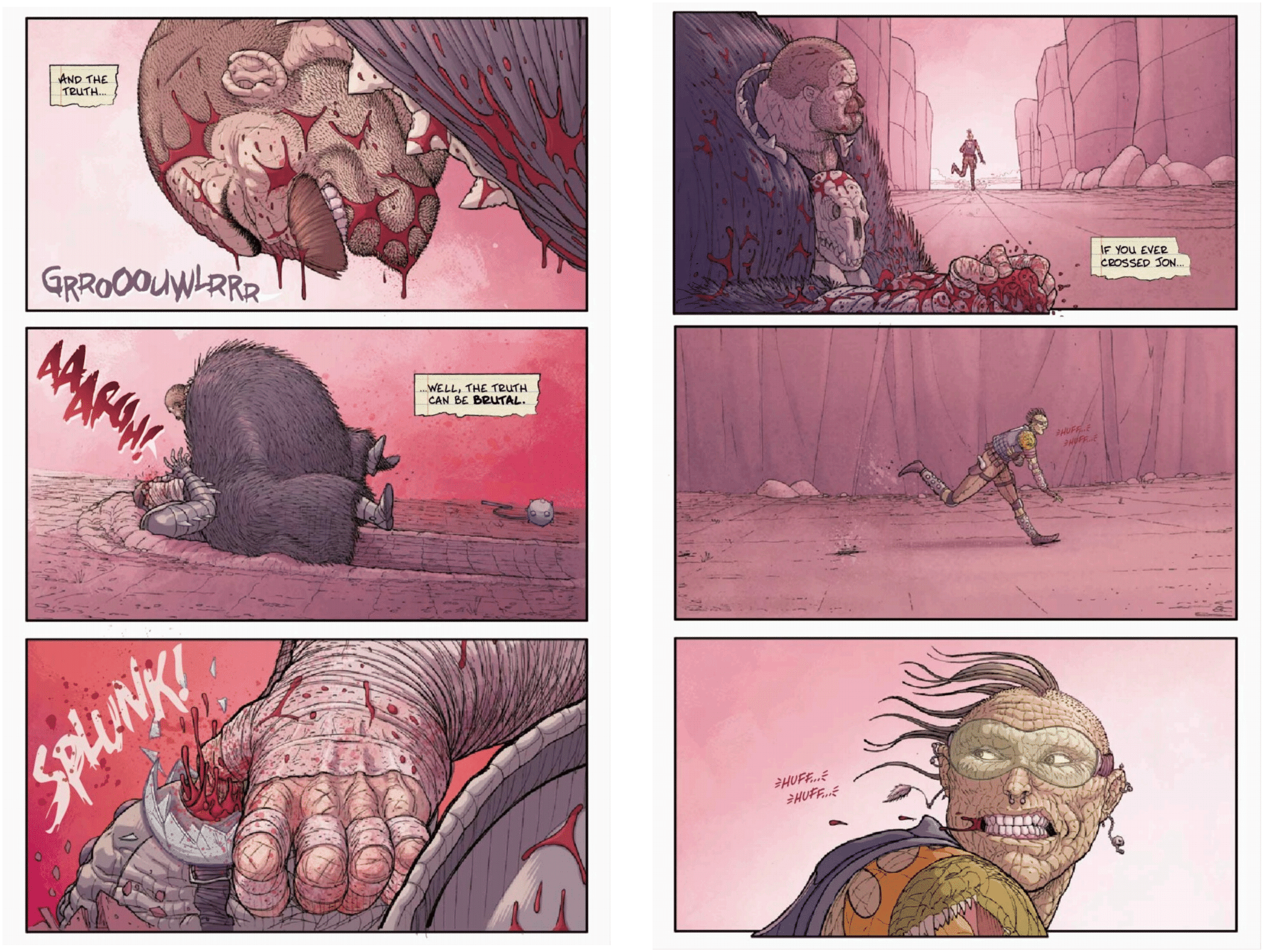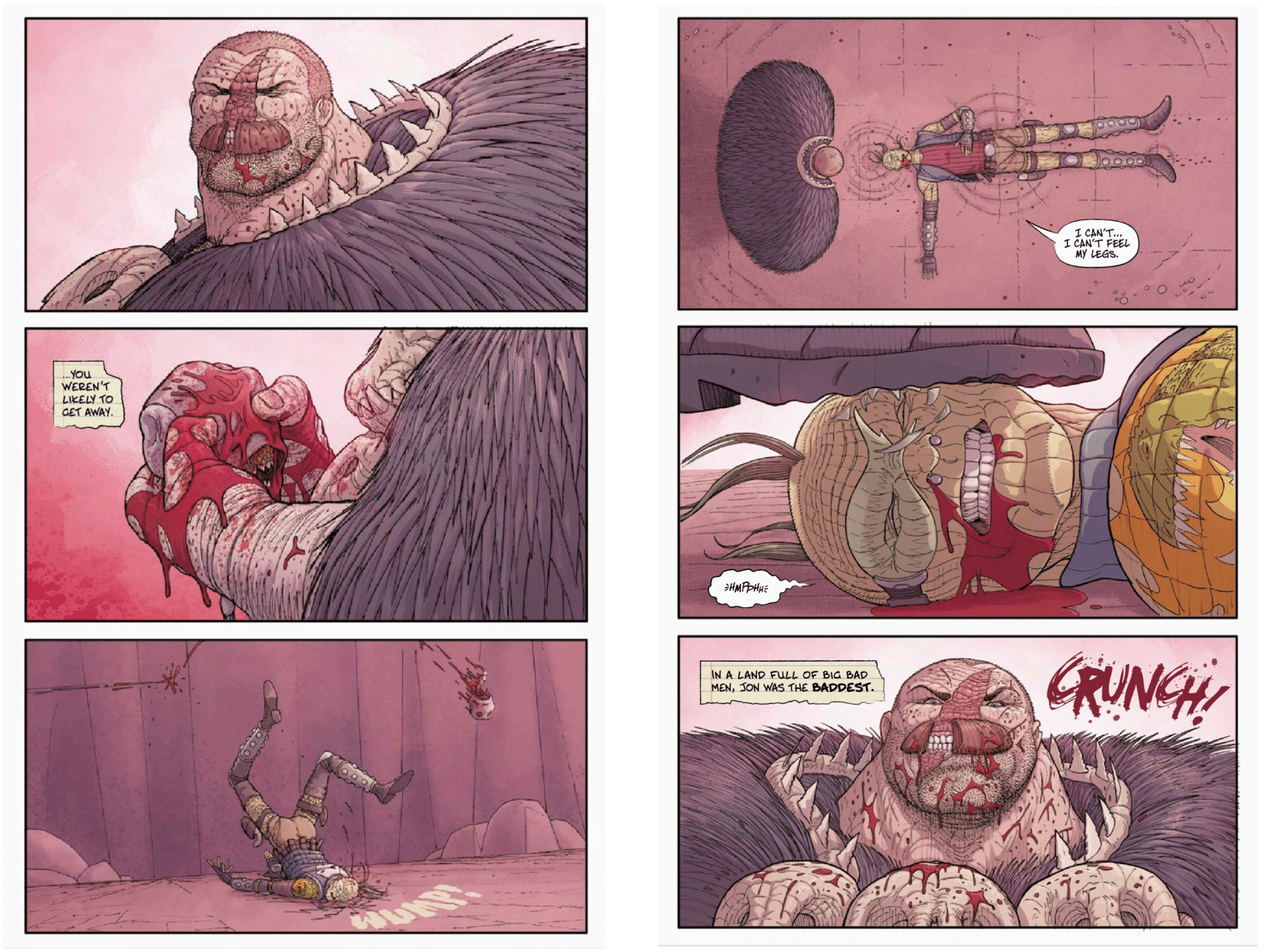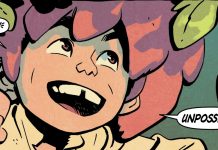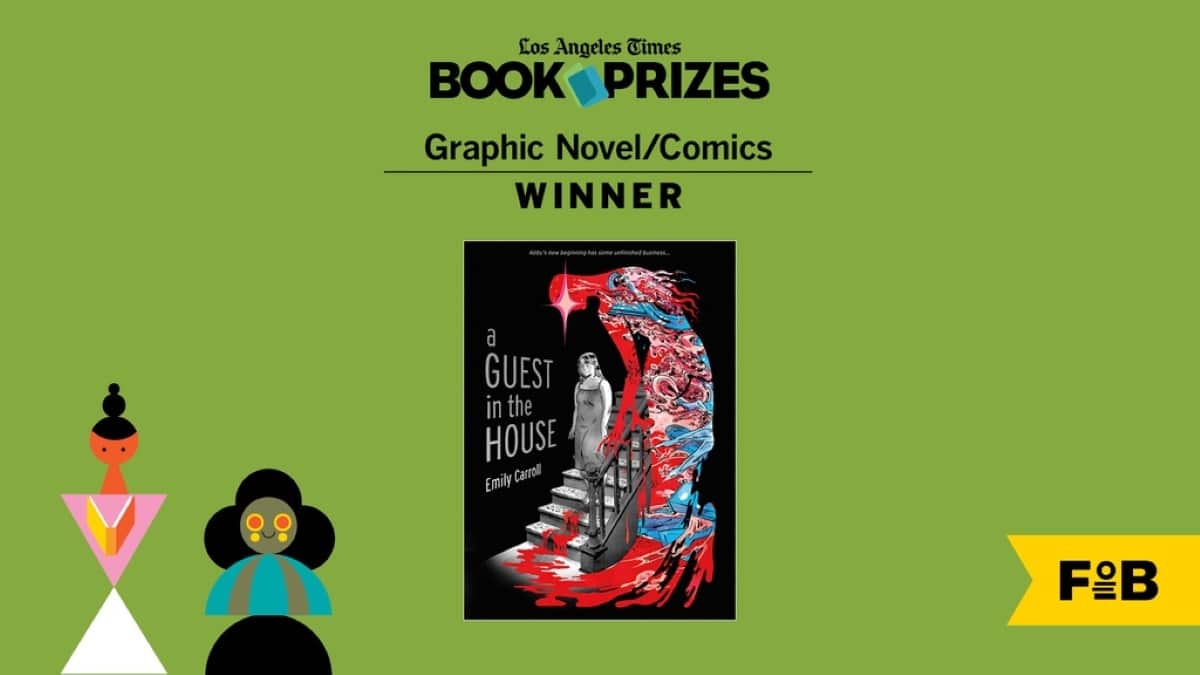The Eisner-nominated and New York Times bestselling co-creator of The Manhattan Projects, Nick Pitarra, is back with Ax-Wielder Jon, a 148-page oversized hardcover story about “a ruthless killer in a world of monsters and mayhem” who, after making a precious discovery, “learns what a man is willing to lose to protect what he loves most,” available to support on Zoop until Wednesday, June 1st. Ax-Wielder Jon is created by Pitarra, with colors by Mike Garland, book design by Ben Didier, and letters by Ferran Delgado. It features a cover by Spanish painter Das Pastoras and a back cover by Nick Derington.
The Beat caught up with Pitarra to ask all about what went into writing his first story set in the surreal reality of Ax-Wielder Jon, to find out about the artists and creative works that inspired him, and to learn about the personal struggle behind how the graphic novel came to be!
This interview has been edited for length and clarity.
Rebecca Kaplan: You’ve previously worked as an artist on numerous projects. However, I believe this is the first comic book you’ve written. How is the process different?
Nick Pitarra: When I worked with Jonathan Hickman on The Manhattan Projects, I was only worried about the sequential storytelling from panel to panel. I wasn’t worried about how the reader was taking in the story as a whole. When I worked with John, we would get together, and I would see him plot out the scripts, and we would go for the first 20 issues, we’ll do this, this, and this.
With Ax-Wielder Jon, I learned a lesson from that, and I had to step back and think, “Okay, for these five pages of real estate, I need to make this point because, in 10 more pages of real estate, I’m going to make a different point.” Now, I’m thinking about how the reader absorbs a story like a whole meal. Before, I was worried about putting pepper on the mashed potatoes, but now I need to worry about the entire cuisine, different starters, etc.
Kaplan: Can you tell me more about the frame narrator who comes into the story?
Pitarra: When I was writing, her voice was there. Then when I went to draw, I thought it might be trite or overused, but I had these big action scenes that would only absorb as a drumbeat if it was just over-the-top action with over-the-top kills. So how could I wrap a through-narrative? I call it zippering scenes because you can only work with scenes – this scene, this scene, this scene. But if a story has a through-narrative or a frame narrator, make a point, absorbing a different angle to the story, [it adds something].
Her voice wouldn’t go away whenever I drew the pages, which took time. I’m drawing each panel on its own 11 x 17 board (usually, comic pages are drawn on 11 x 17 boards). I’ve spent all this time drawing for the last year and a half, and as I’m drawing, her voice would keep coming back. Since she wouldn’t go away when I hired my fantastic editor, Chris Stevens, who’s won a couple of Eisners, and who’ve I wanted to work with him for a long time, I told him, “Man, this girl’s voice keeps returning. Do you think it would work?” And he’s like, “Oh, we need it.” He encouraged me to tease that out in the story. So she became a semi-character in the first book, definitely the frame narrator, and she’ll be the main character in book two. So it was good to establish her in the first book.
Kaplan: There’s a scene in Castle Blackrock where someone’s writing on the notepad. Is that connected to her character? Because it’s the only time, you see something like that…
Pitarra: Everything in the book is going to play out later. The notepad comes back in book two. I don’t think this is a spoiler. Two henchmen are going around, putting in new booby traps. They’ve been putting them in for the last year, and they pulled an old guy out of retirement to oversee this because he’s someone the castle can trust, and there’s this funny gag that I have planned where — it’s kind of like this Alfred Hitchcock thing where if you and I were having this conversation, then it’s normal. But if you show someone putting a bomb under the table and we have a conversation, bad stuff’s coming.
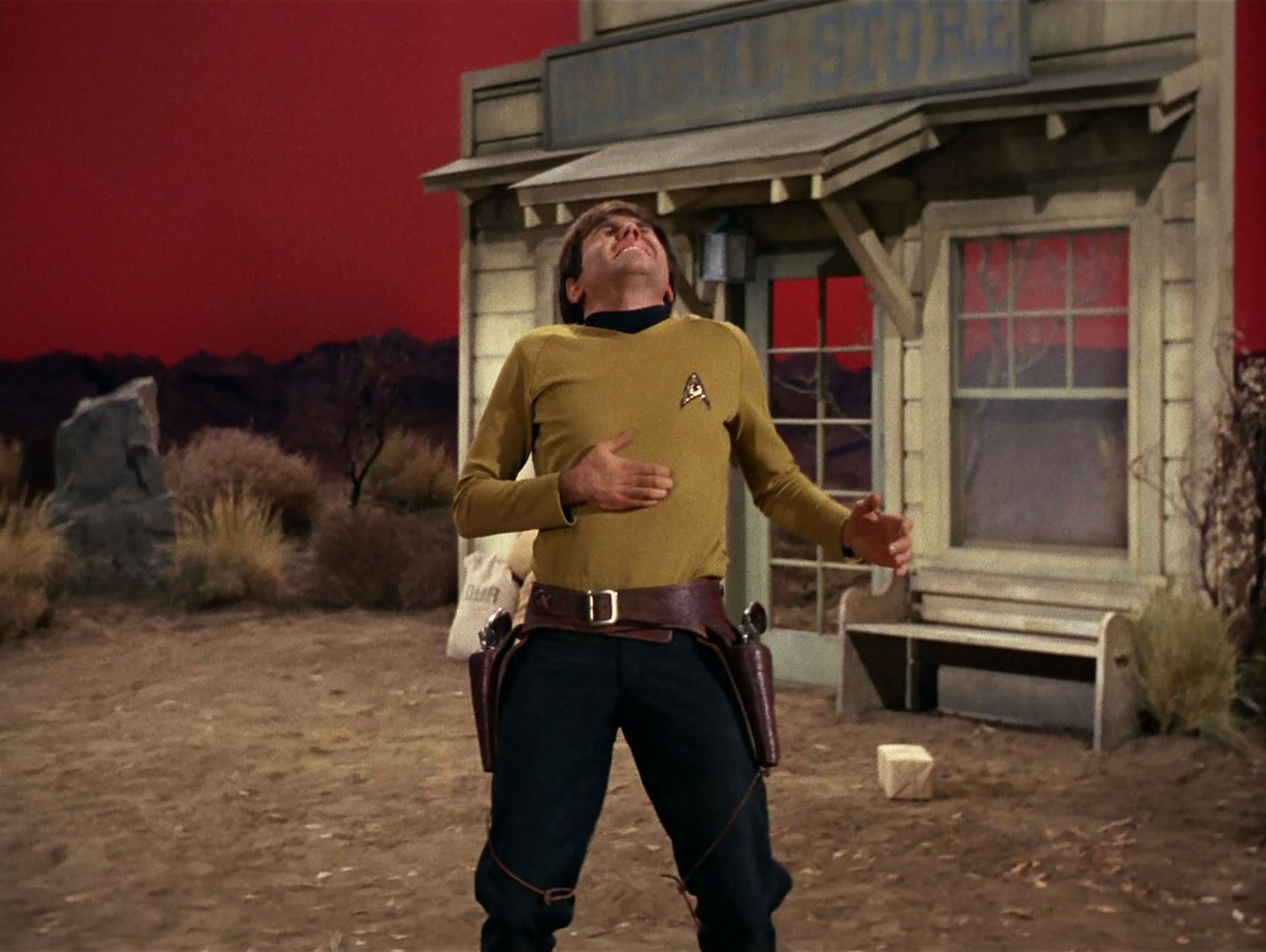
I thought it’d be cool to establish all the killer devices in book one and have this document. So all the documents in the book come back to play. We open with Basil Toymaker, the little girl who is the frame narrator; she’s Jon’s apologist because he’s called all these things, but she wants to put him over as a hero. So Jon, later on, will find that item. And so, all the frame narrating devices — there’s a thing in book two where Basil’s going to stitch a doll of Jon, and as she’s stitching him, we’ll see Basil’s dad stitching up all of his scars. But the doll comes into play later as a plot device. So every item I show off that probably seems nonsensical, I’ve got plans to make them reappear in the comic book.
Kaplan: You just mentioned collecting. How did you get into collecting original comic book art?
Pitarra: Well, I didn’t draw in high school. And then, at 17, I got kicked out of my English class because I wasn’t doing my work, and the only time spot available was a remedial reading class. When I got put in the class, I had nothing to do, but there was a kid who drew all day and did not do his work. He was going to the Joe Kubert School of Art, and I sat next to him and saw him drawing on 11 x 17 artboards, so I got interested in drawing. Eventually, I went to the comic book store with him, and at first, I didn’t connect with any work. But then, I saw the art of Frank Quitely, a very famous Scottish artist. I put two and two together: if he’s drawing on these 11 x 17 boards and there’s this comic, there must be those artboards.
Around the age of 20, I started saving money and buying original art. As I’ve gotten to a professional level with my work, Felix Comic Art sells my work. I try not to take the money and instead buy other people’s art. I try to buy better art than my own. I have lots of cool stuff. I use it for inspiration. I’ll keep them next to my desk, and I’ll draw. And it’s like, man, I’m not that good yet, but it’s a goal to get that good.
With Ax-Wielder Jon, the book is 90% complete. By the time the campaign ends, I’ll be done. But I’ve had to fund it out of pocket — the way the story came to me is my daughter got sick in the hospital when she was first born, and we had to live in the Ronald McDonald House while she healed. And so, the idea for Ax-Wielder came to me because people would say, “Trust the doctors,” or religious people would say, “Give it over to God.” And man, I started doodling a take-no-nonsense hero. When I finished drawing him, I was like, “I’m going to make this book no matter what,” and it almost felt beneath me to ask to draw it: I can create it. I can do this.
The thing about original art is it’s gone up in value. For the last year and a half, when my wife and I needed money, I’ve sold original art from my collection. So, investing in art has helped fund Ax-Wielder Jon, so it’s been a blessing. And then, I haven’t had to ask anyone to make it. I’ve made it the way I wanted to, and ironically, it’s given me this creative freedom: if I have to sell a piece to make ends meet, I will. And now, it’s almost done; I wanted to bring it directly to fans and see if there was a market for it. I’m excited to be working with Zoop to see it come to fruition.
Kaplan: I was a hospital kid. How did creating this story help you through the difficult period?
Pitarra: Basically, we had my daughter home for nine days, and she had a stomach blockage. We brought her to the children’s hospital, and they couldn’t figure out why she wasn’t keeping anything down. We stayed for about two days in the emergency room, but she was getting sicker and sicker and weaker and weaker. They couldn’t decide if they would do a CT scan on her because of the radiation, so they waited. But then, her bowels stopped moving, so they had to do the CT scan and saw she had a blockage, and it had ruptured, and some of her intestines were dying. They had to do stomach surgery, and eventually, they woke her bowels back up and got them moving again, but there were hiccups along the way. You know, we stayed in the NICU for about two months.
We were fortunate and got into the Ronald McDonald House. She had to come home with a colostomy bag, and we had to go from changing diapers to that. And then, eventually, she had to have some reconstructive surgeries. So it was this overwhelming thing, and what I liked about Jon was that it was a distraction in the downtime. You can’t do a lot while someone’s healing and sick.
I like the dilemma with Ax-Wielder Jon where you want to help and fix it, you don’t want to give it over to other people or trust the doctors, but you have to. I thought the dilemma for Jon and the storytelling device that I liked was, “What if a man took no shit from anyone, and he fixed the world his way, but his way was wielding axes, but then give him a problem where wielding axes doesn’t necessarily fix it. Now he’s got to learn.” In the later books, Jon needs to learn the lesson I had to learn. I mimicked myself; I was like, “Well, I’ve got a new family now. Just like Jon sharpens his axes, I will sharpen my pencil and get to work. I’m going to make this no matter what. I’m not going to let anyone tell me I can’t make it, or it’s too violent or has too many curse words. I’m going to make it my way.”
He’s been my inspiration, and that’s been this meta thing. Moebius has this wonderful line about drawing, “An artist encodes reality.” I always took it as an artist takes what he sees, delineates it through his own line, and puts it on the page. But once I started writing, I realized that you also do it with words. I might think I’m doing an action hero comic, but I’m putting fatherhood there. I’m putting stress in there. It’s all trickling in there, so it was fascinating that we encode reality through our fiction, not just our hands artistically.
It’s such an exciting thing about fiction, how fiction mimics reality and reality mimics fiction. You realize you’re on this journey, and you start seeing your creations reinvent themselves or say hi to you in a way. Then, you can see the mimicking of reality on the page. I love all that stuff.
Kaplan: How did you develop the wicked monsters?
Pitarra: I wanted the monsters to be as interesting as possible. I went into Ax-Wielder thinking, “All this has been done before, so how could I do it more over the top? More extreme?” I’m a big Geof Darrow fan, and he does everything crazy and over the top. With the character being called Ax-Wielder Jon, don’t give him one or two axes; give him 50 axes and a bearskin trench coat. There’s a movie called Desperado by Robert Rodriguez, and Danny Trejo is a knife thrower with a vest full of knives. I thought, what if I made a man with a vest full of axes cover him in axes. Then, it became a pretty distinct character right off the bat.
I know the book is machismo, but it has a softer side. So the idea for me, a joke, was giving Jon a big mustache and then having a scar on Jon’s face to break the symbol of masculinity in half. So sometimes the designs are a little laugh to me. However, some of the monster designs are — I love Masters of the Universe and all kinds of pop culture, and I try to be honest about whatever I thought looked good on the page when I was designing the monsters.
Kaplan: What were some of the other influences?
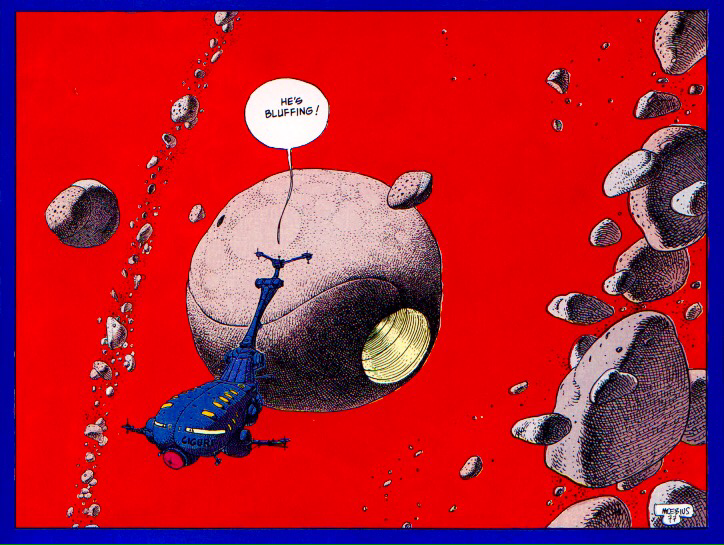
Pitarra: The most significant influence was probably Jean Giraud, this great French artist named Moebius. He did Blueberry and Airtight Garage. He started working in Hollywood and did the designs for the Masters of the Universe movie. So the Skeletor, when Skeletor turns to gold, in the Masters of the Universe movie, is Moebius’ design. I’m fortunate enough to own the original art to He-Man’s design of Dolph Lundgren that Moebius did. So I always thought, “What would it look like if Moebius drew a very serious Masters of the Universe story in an over-the-top way?” So that was a significant influence.
The other influence was Western movies. My favorite is Unforgiven, which has an excellent concept where people say things about William Munny, the main character, but they’re never quite true but maybe they used to be. I learned from the movie there are things people say about you from the outside versus what you know about yourself. And I liked shining those two lights on every character. What can I present to the reader, and they’ll be that? But then what else can I show about them that turns out on its head? And so, Unforgiven and Moebius were the two melds to make Ax-Wielder Jon.
Kaplan: How does it feel to have fan art of Ax-Wielder Jon already?
Pitarra: That was cool. It started with a wonderful artist named Nick Derington, who did Doom Patrol with Gerard Way, and he’s worked on Batman. He’s a good buddy. He drew him, and then I shared it. Then, I said I’m going to put it in the book. And then that started a wildfire because then Chris Samnee, an Eisner award-winning artist, did one. Then, David Marquez, who was a Batman artist, did one. And then fans of all levels and skills started doing it. It was cool. It’s hard to sit alone for a year and a half and draw this book, snd so when those started popping up; it was extra motivation.
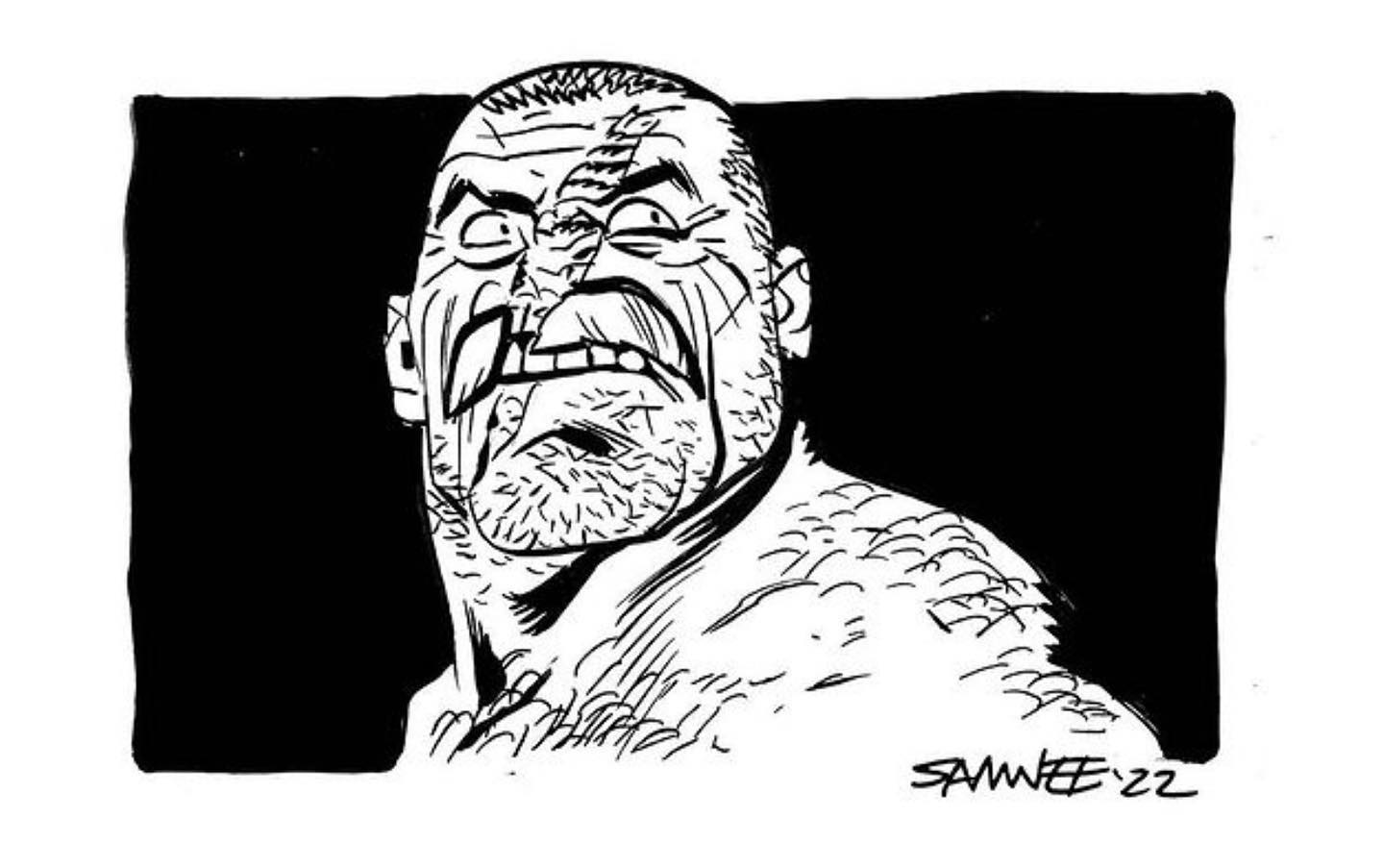
I’m so thankful. I’ve gotten pieces from all around the world. I got a piece from a guy named Matteo Ferrari, and he did this beautiful painting. I wrote him and said, “Can I buy it from you?” I can’t buy them all, unfortunately. I don’t have much money, but I’ve picked up a few, and a few are gifted to me, and it’s been fantastic. I hope it transfers into the campaign. But even if it doesn’t, I’m going to try to print them in the book. I can’t give them their own pages because there are too many, but I will put four on a page and get them all printed in the book.
For Jon to start living in other people’s imaginations and for people to bring him to life through their craft and in their own hands has been incredible. It makes him feel he’s lived a long time before the book is even out—that’s what I’m truly thankful for.
Kaplan: I saw that someone even designed an action figure already.
Pitarra: Three guys now, two 3D modelers, one made a complete beautiful action figure, and one made a bust, and then in the campaign, I always had those rubber men muscle figures in the 80s, so I had a guy design one and got a prototype made. It’s been incredible.
Then, a miniature toy company reached out. They asked for an advanced copy of Ax-Wielder Jon, and I sent it to them, and we signed a deal to bring it to tabletop gaming. It’ll take a couple of months to get a prototype, so it’ll be a later thing, but still very cool. There will be four different types of figures out there of Ax-Wielder Jon, which is incredible because no one’s even seen the book yet. So yeah, I was very tickled with it.
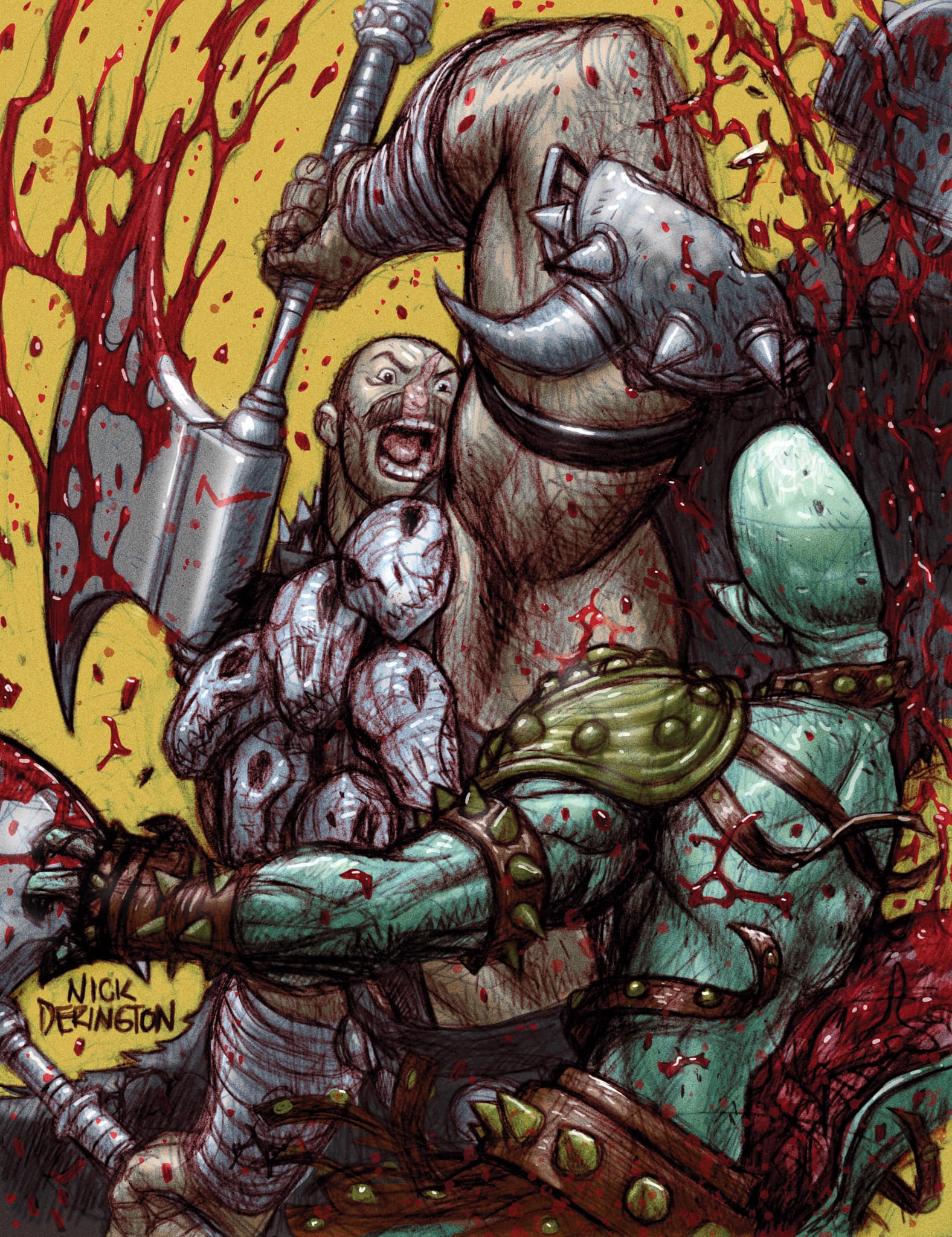
Kaplan: Does it make you nervous at all?
Pitarra: I’ve built up what little reputation I have as a very silly artist. I don’t think Jon is as silly as people will expect. It’s over the top in a strange book sense, but there is a little bit of a feminine side that people don’t know about yet. I hope to surprise readers with my writing, but we’ll have to see how it goes. It doesn’t make me that nervous because I’ve worked hard on the book. However, if all these people from all over the world did these 60 sketches and took the time to design toys, and then it’s a stinker, I’ll feel bad.
Kaplan: Is there anything about the Zoop campaign readers might not know?
Pitarra: Kickstarter reached out to me and offered me their premium spot, and I turned it down. I think Zoop’s the future of crowdfunding, at least with comic books, because fulfillment is lined up. So for me, it was straightforward. I can make the book I want and get it on a platform. I have direct contact with the people running Zoop versus Kickstarter, where you might not have the same access. And then, the printing is lined up through services you pay for through Zoop.
You should know there’s more security to get your products on time on the customer end. As a customer, fulfillment and customer service are lined up. With Zoop being a new platform, the hardest part is to tell people to go to a new website.
The Zoop for Nick Pitarra’s Ax-Wielder Jon is live now and runs until Wednesday, June 1st, 2022.


